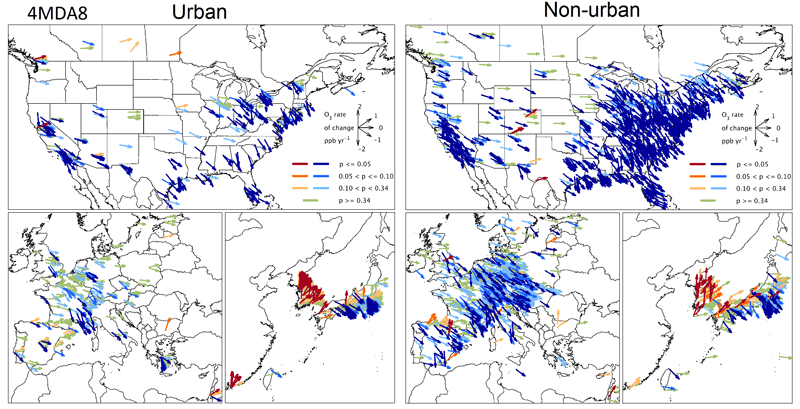
New research led by the Universities of Leicester and Edinburgh and twelve other institutions worldwide (listed below) has analysed ozone levels across the globe, with some regions of East Asia showing increasing levels of ozone air pollution.
The research is a component of the Tropospheric Ozone Assessment Report (TOAR), an international effort to improve scientific understanding of ozone’s global distribution and trends. Published on 5 February in the scientific journal Elementa: Science of the Anthropocene, the results are said to provide the most ambitious ever ground-level ozone assessment, using data from over 4,800 monitoring stations across the globe.
As part of the study, ozone levels potentially detrimental to human health have been assessed where data are available, both in urban and non-urban areas worldwide. There is considerable variation within regions and hot-spot locations with the highest ozone levels have been identified.
Changes in ozone levels from trend analysis shows that ozone has decreased in much of Europe and North America over the last 15 years. However, the research shows that ozone is rising in some parts of East Asia over the same period, reflecting increasing development and pollution emissions.

Previously, analyses of ozone trends at individual or smaller groups of sites often left researchers unable to draw robust conclusions about regional trends in areas such as Europe and North America. The large number of sites now included in this more comprehensive dataset have allowed for more robust conclusions that reveal that a decrease predominates in these regions.
Dr Zoё Fleming, from the National Centre for Atmospheric Science (NCAS) at the University of Leicester’s Department of Chemistry, said: “TOAR is the most ambitious project to date to assess global ozone levels at the surface of the Earth, helping us to better understand potential human health impacts.

“Despite some improvements in air pollution emissions in Europe and North America, human health impacts from ozone are still a cause for concern across the world and are rising in East Asia, with the potential for serious health consequences on their populations.
“There is an increasing awareness of the issues of human health from poor air quality and making such a database freely available and disseminating the results from the study will inform the public on the health implications of ozone.”
The data come from certified monitoring stations with rigorous calibration procedures. Statistical analysis was carried out on the data, in order to calculate peak and high ozone levels and to interpret trends and changes in the data. The study uses five different recognized methods for measuring the daily or seasonally highest ozone levels. These so-called metrics show similar patterns and highlight the different assessment methods. TOAR has created a large publicly available database which also includes a complete set of statistics and graphical downloads (https://doi.pangaea.de/10.1594/PANGAEA.876108).
Air quality monitoring is a crucial element for quantifying current air pollution levels and evaluating the effectiveness of emissions controls and informing the evolution of air pollution policy. There are still large regions of the world where such monitoring is sparse or non-existent. To effectively understand and tackle air pollution, expanded monitoring is critical.
Ozone insight
Professor Ruth Doherty, from the School of Geosciences, University of Edinburgh, said: “The ability to quantify for urban regions worldwide the changes in high and peak ozone levels over the last 15 years and longer is an exciting research development, that we hope will be useful to air quality managers to inform and evaluate strategies to protect human health from the adverse effects of ozone.”
Dr Owen Cooper, from the Cooperative Institute for Research in Environmental Sciences, University of Colorado, Boulder, Colorado, US, said: “TOAR was made possible by an international team of scientists who volunteered their time and expertise to build the world’s largest database of ozone metrics and then made those data completely open access.”
The research is funded by the International Global Atmospheric Chemistry project (IGAC), the World Meteorological Organization (WMO), the National Oceanic and Atmospheric Administration (NOAA) and Forschungszentrum Jülich with the support of a large international team of experts who recognized the need for an up-to-date tropospheric ozone assessment.
The other institutions involved were the Institute for Advanced Sustainability Studies (IASS) and Forschungszentrum Jülich in Germany, the Universities of Colorado, North Carolina-Chapel Hill, and Maryland as well as A.S.L. and Associates in the U.S., the Stockholm Environment institute in the UK, INERIS in France, the Chinese Academy of Meteorological Sciences and Chinese Academy of Science in China, NILU (Norwegian Institute for Air Research) and the Norwegian Meteorological Institute in Norway, Chalmers University in Sweden and the University of Witwatersrand in South Africa.
More information about the Tropospheric Ozone Assessment Report (TOAR) is available here.
A copy of the paper ‘Tropospheric Ozone Assessment Report: Present-day ozone distribution and trends relevant to human health’ published in Elementa: Science of the Anthropocene is available here from Monday 5 February 2018.






